



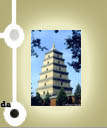
| Xi'an/Chang'an | |
|
Learn here about Xi'an/Chang'an, the greatest city in the world during much of the first
millenium CE:
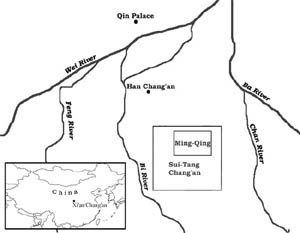
|
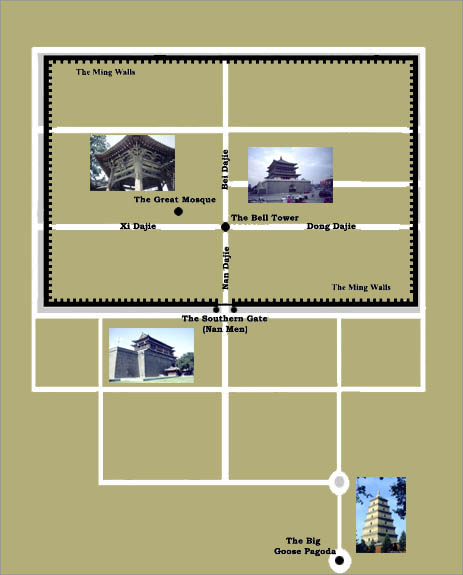
|


|
The central location of Xi'an in what is now Shaanxi Province near the confluence of the Wei and Feng Rivers helps explain why the area
was the site of several important imperial capitals for about a millennium of Chinese history. The first really unified Chinese
empire, that of the Qin, had its capital just north of the current city of Xi'an. Although the Qin emperor failed to establish a lasting
dynasty (he died in 210 BCE), in some ways he is the Chinese ruler best known outside of China because of his massive tomb complex with
its terracotta statues of more than 8000 soldiers and their horses, spread over some 56 square kilometers. Its discovery in the 1970s was
arguably the most important archaeological find of the twentieth century. Only a part of the site has been properly excavated and the
figures restored. Recent work on some of the other Chinese imperial tombs in the area provides a tantalizing hint of spectacular finds
to come over the next decades.
Street wards are deserted and desolate; Town dwellings are sparsely scattered. The buildings and offices, stations and bureaus, Shops and markets, official storehouses, Are now concentrated on a single corner of the wall-- Of a hundred, barely one survives... Great bells have fallen in the ruined temple; Bellframes have collapsed and suspend no more... Chang'an revived in the fourth century, once more the capital, and witnessed a cultural florescence in part thanks to the fact that it became a center of Buddhist learning. Several important Buddhist pilgrims and translators resided there around the beginning of the fifth century, among them Faxian, who traveled to India, and the scholar Kumarajiva. The revival came to an end in civil strife, and for over a century after a conquering army took the city in 417, it ceased to be the capital. A brief revival in the second half of the sixth century ended abruptly with the accession of the Sui dynasty in 581, since the first Sui emperor decided to build an entirely new city to the south of Han Chang'an and on the exact location of the modern Xi'an. According to Prof. Xiong, the choice of the site and the layout of the city was in part determined by divination with reference to astrological signs. The city continued to be the principal capital of the Empire and entered the greatest period of its development under the Tang Dynasty (618-904). "At the height of its glory in the mid-eighth century, Chang'an was the most populous, cosmopolitan, and civilized city in the world" (Richard B. Mather, foreword to Xiong, p. ix), occupying some 84 sq. km. with around one million inhabitants. The poet Lu Zhaolin provided a vivid description of an imperial procession through the city: Chang'an's broad avenues link up with narrow lanes, where one sees Black oxen and white horses, coaches made of seven fragrant woods. The emperor's jade-fit palanquin sweeps past the mansions of princesses, Gold riding whips in an unending train point toward marquises' homes. The dragon biting the jeweled canopy catches the morning sun, The phoenix disgorging dangling fringes is draped with evening's red clouds. (Tr. Stephen Owen, modified by Xiong, p. 201.) It suffered major damage during the An Lushan rebellion in the mid-8th century, but even toward the end of the Tang period, when the empire was in disarray, the "enormous size" of the city impressed an Arab visitor. The Tang period was one of the most noteworthy ones for the impact of Western products and fashions on Chinese elite culture, and the teeming markets of the capital played a significant role in the dissemination of such goods. Among the dominant figures at least under the early Tang (in fact their presence in China can be documented from several centuries prior to that) were Soghdian merchants from the region of Central Asia which encompasses today's Samarkand. The poet Ban Gu evoked the crowds of the markets: In the nine markets they set up bazaars, Their wares separated by type, their shop rows distinctly divided. There was no room for people to turn their heads, Or for chariots to wheel about. People crammed into the city, spilled into the suburbs, Everywhere streaming into the hundreds of shops. (Tr. David Knechtges; cited by Xiong, p. 165.) |
|
Images shown here of the busy streets of Xi'an today cannot begin to capture the feel of the bustling markets of the Tang capital. 



|
|
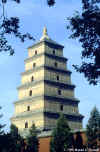

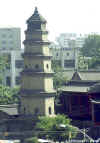
|
The various monasteries took part, each arranging fine offerings. All sorts of medicines and foods, rare fruits and flowers, and many kinds of incense were carefully prepared and offered to the Buddha's tooth. They were spread out beyond count in the gallery around the storied offering hall...All the Reverences of the city were in the storied hall adoring it and making praises. The whole city came to worship and make offerings. One man donated one hundred bushels of non-glutinous rice and twenty bushels of millet. Another man provided biscuits plentifully and without restrictions. Another man donated enough cash for the miscellaneous needs of the meals...People tossed cash like rain toward the storied hall of the Buddha's tooth. He goes on to note that there were four teeth of the Buddha in the city, three of them having come respectively from India, Khotan and Tibet and the fourth from heaven. |


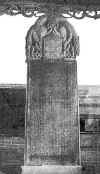
|
The spread under the Tang of the religions other than Buddhism can be documented fairly specifically. A stele (inscribed stone pillar) erected in 781 relates the introduction of Nestorian Christianity as early as 635 by Syrian priests. This famous stele was largely neglected in a field outside Xi'an until the beginning of the twentieth century, when it was moved to the location in the city where it can can be seen today in the "Forest of Stele" museum. The text and carvings exhibit a curious syncretism of Christian and Chinese traditions. Zoroastrianism received some impetus when the last of the Sasanian (Iranian) princes Firuz took refuge in China in the 670s, having fled the Arab invasions. Manichaeism also was connected with the arrival of Persians at the Tang court as early as 694; it really flourished though only after the An Lushan rebellion in the mid-eighth century, when the Tang dynasty was saved by the support of the Manicheaen Uighurs. Enin was one of the first to note how the Emperor turned viciously on the Manichaeans when the Uighur empire disintegrated in 840, and he stayed long enough in Chang'an to witness the onset of severe persecution of Buddhism, which lasted from 842-845. The emperor was persuaded by his Confucian advisers that Buddhism was siphoning off too much wealth; the situation was undoubtedly compounded by a sense of growing crisis as the Tang state weakened. Buddhist scripture were burned, monks and nuns were forced to abandon the religious life. In the capital various disorders broke out: Four [imperial] Secretaries...were decapitated on Imperial command and their men and women and their slaves were all killed and their houses destroyed...In the third watch of the night (midnight) fire broke out in the Eastern Market and burned over four thousand houses in twelve alleys westward...Public and private money and gold, silver, silks, and drugs were all destroyed...In the third watch of the night a fire broke out in the Palace...Fire broke out outside the Ch'ang-lo Gate and burned a hayloft. Previously there had been an Imperial edict to burn the Buddhist scriptures in the Palace and also to bury the images of the Buddhas, Bodhisattvas, and Heavenly Kings. Later fire broke out in two places and still later, on two nights, fire broke out again in several places in the Eastern Market. The glory days of Chang'an were numbered. |


|



|





|
Undoubtedly it was in the Ming period that the large Muslim community in Chang'an really took root and its members became largely sinicized. Muslim merchants arrived in China much earlier both by sea through the ports of the South China coast and from Central Asia, but they had been required to live in enclosed communities which the Chinese authorities kept largely insulated from serious cultural interaction with the Chinese. We know that by the sixteenth century, however, many of the Chinese Muslims apparently knew little Arabic or Persian, they had become so assimilated. While it is claimed that Chang'an's Great Mosque (Qingzhen Dasi) was first built in 742, there is some doubt as to whether it or any other mosques in Chinese cities are anywhere near that early in date. The buildings one sees today in the mosque date from the late Ming period. For example, its entrance gate was erected in 1600-1629. In its arrangement of courtyards and purely Chinese-style architecture, the mosque is visual evidence of the degree to which there was a syncretism of Islam and at least some of the externals of Chinese culture. The Inscription on the "One God Pavilion" is the Muslim declaration of faith "God is One" rendered in Chinese characters. The mosque as we see it today is located in a Muslim quarter of Xi'an, not far from the location of the western market whose merchants played an important role in the continuing trade of Ming and Qing times through the Hexi corridor into the Western Lands--that is along the classic Silk Road to Inner Asia. 
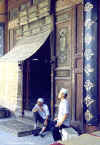

|
 Back to Top |
Recommended reading: Much of the material here has been drawn from Victor Cunrui Xiong, Sui-Tang Chang'an: A Study in the Urban History of Medieval China (Ann Arbor: Center for Chinese Studies, The University of Michigan, 2000), which is the only work of substance on the city available in English. Those wishing information on the spectacular archaeological discoveries in the region, beginning with the terracotta army, can find several articles in National Geographic. Enin's fascinating account has been translated by Edwin O. Reischauer: Ennin's Diary: The Record of a Pilgrimage to China in Search of the Law (NY: Ronald, 1955). The best source for information on the exotica imported into China under the Tang is Edward H. Schafer, The Golden Peaches of Samarkand: A Study of T'ang Exotics (Berkeley, etc.: UCalif. Pr. PB, 1985). An excellent overview of the early history of Islam in China is in Jonathan N. Lipman, Familiar Strangers: A History of Muslims in Northwest China (Seattle; London: Univ. of Washington Pr., 1997), Ch.2. The old photos of Chang-an and the Nestorian stele are from Frits Holm, My Nestorian Adventure in China (New York, etc.: Revell, 1923); A translation of the text of the stele is available here and there are useful discussions of Nestorianism in China by Fred Aprim and Emmanual Tamras; Frits Holm, The Nestorian Monument: An Ancient Record of Christianity in China (Chicago: Open Court, 1909). The map of the several locations of Xi'an/Chang'an is based on that in Xiong; the map of Xi'an and its monuments today is based on one in the best guidebook for tourists interested in our subject, Peter Neville-Hadley, China and the Silk Routes (London: Cadogan, 1997). © 2001 Daniel C. Waugh. Last updated December 27, 2001. |